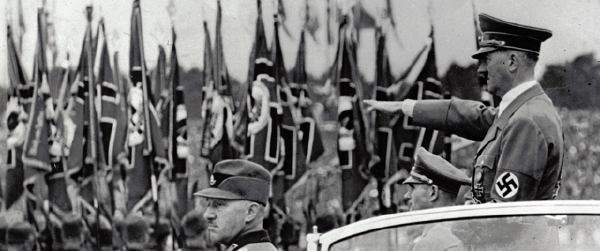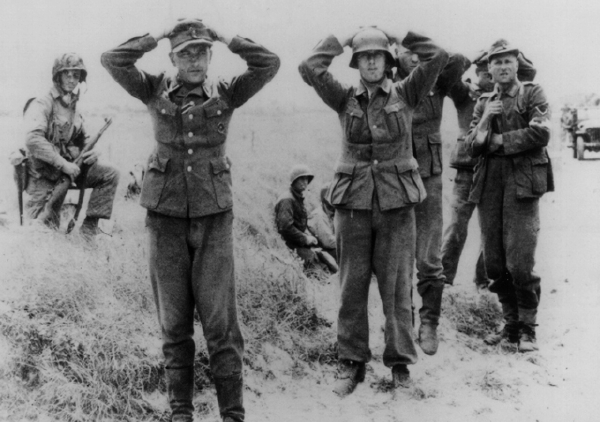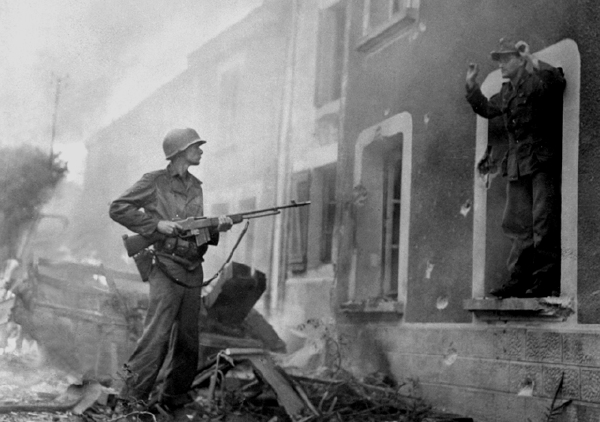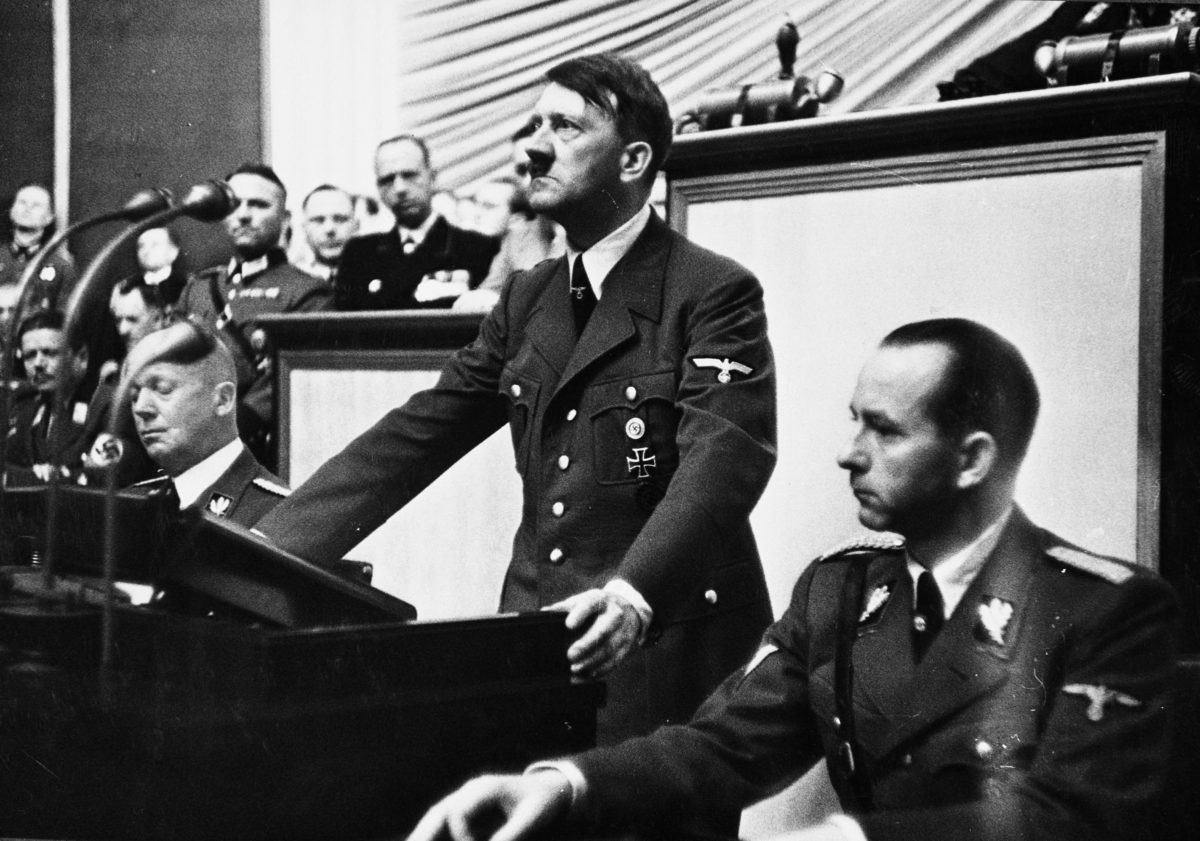
By overruling his senior officers and achieving a string of stunning victories in the years leading up to World War II, Adolf Hitler came to be considered, and considered himself, a military genius. He masterminded the march into the Rhineland in 1936, the annexation of Austria two years later, the subsequent annexation and dismemberment of Czechoslovakia, and the invasion of Poland in 1939. Hitler’s seemingly unerring political, military, and diplomatic judgment fed a messianic conviction of his invincibility.
When mixed with dictatorial power and a growing propensity to react to strategic differences with towering rages, the result proved a fatal brew—one that had the ironic effect over time of turning Hitler into one of the Allies’ most effective weapons. At almost every point where an important decision was required, the Nazi leader could be counted on to make the one that inadvertently benefited the Allied cause, and helped to doom his own. A complete catalog of Hitler’s failures as a war chief could fill a thick volume; a dubious honor roll of the worst of them follows.
Declares War on the United States
On December 8, 1941, President Franklin D. Roosevelt went before Congress and asked for a declaration of war against Japan. Germany was never mentioned. There was little popular support to expand the war; unless Hitler made some gesture of monumental stupidity, the United States at the time had no official reason to declare war on Germany. British and American strategists were frustrated. They had always presumed that once the United States entered the war, defeating Germany would take priority over Japan. But now it appeared America would take on Japan first while Great Britain fought alone against Germany.
Fortunately for them, four days after Pearl Harbor, Hitler committed one of the most monumental blunders in history. While President Roosevelt needed 517 words to declare war and doom Japan, when Hitler went before the Reichstag he required just 334 to seal the fate of the Third Reich.
In the final month of 1941, a perceptive observer may have noticed the first glimmers of hope for the Allied cause, as German prospects took a turn for the worse. Britain was not only unbowed, it was actively counterattacking wherever possible. More worrying for the Germans was the Soviet counterattack in front of Moscow, where fresh Siberian divisions were tearing at the Wehrmacht’s Army Group Center.
Despite these rapidly darkening skies, Hitler, upon hearing news of Pearl Harbor, left his Prussian headquarters—where he had gone to personally deal with the Russian winter offensive—and rushed to Berlin. On December 11, he went before the Reichstag to declare war on the United States. It was an act of suicidal hubris. Although Germany was already locked in a war against Great Britain and the Soviet Union, Hitler, when presented with the opportunity to declare war against a nation capable of producing as many munitions in one year as Germany could in five, did not hesitate or flinch. It was not his first serious blunder, nor his last. It was, however, his most colossal.
Why did he do it? This question has long puzzled historians. Hitler was certainly aware of America’s production potential, for he had written about it in Mein Kampf. The simplest answer is that despite this knowledge, he remained unimpressed with American military potential. In 1940, he had told Soviet Foreign Minister Vyacheslav Molotov that the United States would not be a threat to Germany for decades—“1970 or 1980 at the earliest.” Moreover, Hitler had always believed that war with the United States was inevitable. For him, it was better to have that war at a time of his choosing, and when he could count on Japan siphoning off significant amounts of American power. So Germany, for the second time in a generation, found itself in a two-front war against the combined might of the world’s greatest economic powers.

Issues Halt Order at Dunkirk
Still, there was one brief moment when Hitler had it within his power to win the war on one front and remove both France and Britain from his list of antagonists. It had come more than a year and a half earlier, on the coast of northern France. On May 10, 1940, German spearheads brushed aside light resistance in the Ardennes Forest before smashing through the French defensive line at Sedan. Slashing across France, General Heinz Guderian’s panzers entered Abbeville, 20 miles from the English Channel, a mere 10 days later. The French army, cut in half and thrown off balance, never recovered its equilibrium.
But even as the Wehrmacht was finishing off France, Hitler’s next actions guaranteed the survival of another of his foes, the British Expeditionary Force (BEF), thereby presenting his most committed opponent, Winston Churchill, with a gift of inestimable value: an army with which to continue the struggle.
On May 23, the leading panzer units were only 18 miles from the port at Dunkirk, closer to it than most British units. Although the German troops were exhausted from two weeks of continuous marching and fighting, local commanders judged that they could easily capture the port, and thereby trap the British Army in France. Sensing that a crushing victory was near, Wehrmacht commander in chief Walter von Brauchitsch ordered the city taken. But just before the tanks went forward, Hitler issued his infamous “halt order,” stopping them outside Dunkirk.
He never mentioned his rationale for the order; guesses include Hermann Göring’s assurance that the Luftwaffe could complete the destruction of the BEF, and Hitler’s reluctance to risk his valuable panzers in the unfriendly marsh terrain of neighboring Flanders. Whatever the reason, the halt gave the British two precious days to solidify their defenses around Dunkirk, permitting them to carry out the most famous sealift of modern history. In that end, the Royal Navy, assisted by some French warships and a flotilla of 800 private vessels, pulled 338,226 troops off the beaches at Dunkirk, including 118,000 French, Belgian, and Dutch soldiers. These rescued men provided a veteran core around which Britain rebuilt its army.
Overlooks U-boats’ Potential
With the Royal Navy protecting the English Channel and the Royal Air Force denying air dominance to the Luftwaffe, England was safe from invasion. Still, Hitler had one weapon that could take Britain out of the war: the U-boat. In 1917, U-boats came close to bringing Britain to its knees. Despite this, Hitler was slow to see their value. If, during the second half of the 1930s, he had taken the resources wasted on the construction of an almost useless surface fleet and instead applied them to the construction of U-boats, Germany could have started the war with hundreds of these silent killers, rather than 57.
Even with their paucity of numbers, the U-boats came within a hair’s breadth of knocking Britain out of the war. By the middle of 1940, Germany had only 25 U-boats left in service. Still, they managed to sink close to 700,000 tons of Allied shipping by the end of the year, or over 225 merchant ships. Despite that success, it was not until February 1941 that Hitler issued Führer Directive 23, ordering a crash program of U-boat production.
Germany went on to build more than 1,100 U-boats during the war, with over 450 still in service in 1945. By early 1943, the U-boats had Britain in desperate straits, and winning the Battle of the Atlantic became the Allies’ top priority. Then, in March 1943—almost imperceptibly at first—the tide started to turn. A combination of better tactics, new antisubmarine technology, and a broken German naval code turned the North Atlantic into a submarine graveyard.

U-boats continued sinking Allied ships until the end of the war, but their own losses were unacceptably high. In the end, Germany lost almost 800 U-boats and some 30,000 crewmen. Although they sank close to 14 million tons of Allied shipping, that impressive total was overwhelmed by the nearly 40 million tons of additional shipping the United States alone built during the war. Considering that the entire British merchant fleet in 1940 was less than 18 million tons, it is clear that if Germany had started the war with as many U-boats as it ended with, Britain could not have survived long.
Opens Vast Second Front
But Britain did survive, and was still defiant when Hitler made a blunder second only in folly to his gratuitous declaration of war against the United States: the launch of Operation Barbarossa, the invasion of the Soviet Union in June 1941.
Slightly more than two decades had passed since Germany had last launched a two-front war—and suffered devastating consequences. It therefore took a stunning level of strategic incompetence on Hitler’s part to initiate a war in the East when the outcome in the West was still at issue. Tenacity, coupled with flashes of tactical and operational brilliance, kept the German army in the field for four bloody years. And once again, the German military almost made good on Hitler’s gamble. But such martial attributes were insufficient to overcome the fundamental strategic mistake that placed them deep into Russia to begin with. It took a number of additional blunders on Hitler’s part to crush German hopes of a Drang Nach Osten—“Drive to the East.”
Fails to Take Moscow
The first of those blunders came soon after Operation Barbarossa was launched. From the outset, Hitler’s military leaders knew that speed was of the essence: they were after a quick contest, not a protracted war. And their initial prospects of winning that race against time were promising: after smashing through the Soviet forward divisions, Army Group Center won a hard-fought battle at Smolensk. At its conclusion, more than 200,000 Soviet prisoners were marched into already overcrowded holding pens, and the road to Moscow was laid bare. Now was the time for a strong, direct thrust at the Soviet capital.
More than just a political objective, Moscow was the nerve center for the Communist Party, a major industrial center, and, most important, the nexus for almost every major rail line in the Soviet Union; if Moscow fell, lateral movement of Soviet forces would become impossible. Moreover, the defeat of Moscow would help cut western Russia off from the eastern armies, which were already beginning their move to the city’s aid. In 1812, Russia could give up Moscow to Napoleon and suffer few military consequences. Losing Moscow in 1940 would have been catastrophic to the Soviet cause.
But then Hitler shifted Germany’s strategic emphasis: rather than send his forces on to Moscow, at the end of August Hitler ordered General Heinz Guderian to take his Second Panzer Army south to assist the slow-moving Army Group South. By way of explanation, he pointed to the natural resources of the Ukraine and the oil in the Caucasus, both of which he saw as vital to the German war effort. When his generals persisted in protesting this shift in strategy, Hitler exclaimed, “My generals know nothing of economics!” Reluctantly, Guderian took his panzers south, netting another 600,000 prisoners in the Kiev pocket. It was the greatest tactical victory of war, but it was not without cost.

When the advance on Moscow—Operation Typhoon—was renewed on October 2, a precious month had been lost. A combination of stubborn Russian resistance, German overextension, and abysmal weather soon stalled the German offensive just short of its ultimate objective. In late November, when Typhoon was called off, lead German elements were less than 20 miles from Moscow. Only two weeks later, the Russians launched a crippling winter counteroffensive. Unlike Napoleon’s Grande Armée, which was shredded after its victory by both the Russians and the winter, Army Group Center did not disintegrate. It did, however, suffer horrific losses and was never again in a position to threaten Moscow. Hitler’s chance for a quick and decisive outcome in the East dissolved.
Overvalues Stalingrad as a Target
All hope for victory was not lost, however. In the spring and summer of 1942, a restored Wehrmacht launched a new offensive to secure the Caucasus oil fields. It was at this point that Hitler made a series of misjudgments that doomed a German field army and had dire effects on the overall war effort.
After chastising his generals about Moscow being a mere political target of little military consequence, Hitler, remarkably, allowed himself to be drawn into a battle of prestige for control of Stalingrad. Instead of focusing on the oil fields, he divided his force, sending one to head south toward Baku, the other to take Stalingrad. It was a battle he waged ferociously, long after the city had lost any military utility. Division after division was fed into the Stalingrad maelstrom, where whole battalions were virtually obliterated 24 hours after their commitment. For almost three months, the German Sixth Army pounded at the city until only a small sliver remained in Soviet hands.
Myopically focused on capturing the city named for his mortal enemy, Hitler took no notice of the buildup of Soviet reserves on Sixth Army’s weakly held flanks. When the Soviets launched an attack to encircle Sixth Army—Operation Uranus—in mid-November, they quickly shattered first the Romanian and later the Italian and Hungarian armies flanking the city. Two days later, Soviet pincers met at the nearby town of Kalach, entrapping the Sixth Army. For several months the doomed army slowly starved, before finally surrendering on February 2, 1943.
Hitler’s maniacal insistence on seizing and holding Stalingrad had cost over 750,000 causalities, and the loss of an irreplaceable field army. It was, up to that point, the greatest single disaster the German army endured.
Gambles All at Kursk
Eventually, the Soviet Stalingrad offensive petered out, and the Germans were given breathing space to consolidate a new defensive line and restore their depleted forces. If they were to have any chance of negotiating a favorable peace, now was the time to fortify in depth, build mobile strike forces for counterattacks—such as Erich von Manstein’s successful counteroffensive at Kharkov in February–March 1943—and husband their strength to meet the next Soviet offensive.
Instead, Hitler became fixated on a massive summer offensive aimed at an enormous bulge in the Soviet line around the city of Kursk. Ordering simultaneous thrusts from the north and south, he hoped to trap the Soviet forces within the bulge, or salient, and to tear a gap in their line, allowing the offensive to continue to the east.
If it was the Battle of Stalingrad that decided Hitler would not win the war, it was the Battle of Kursk that decided he would lose it. Aware of the massive preparations the Russians were making around Kursk, many German generals were reluctant to attack; even Hitler had doubts, admitting that the thought of the attack made him feel ill. Despite his foreboding, Hitler eventually ordered it to go forward.

It is a testament to German tactical ability that for 10 days the Wehrmacht pushed doggedly ahead. And for one brief moment, it even seemed as if the horrific losses inflicted upon them would not be in vain. The final defensive belt was breached and the armor of the Fourth Panzer Army massed for the final push. It was at this moment that the Russian commander, General Georgi Zhukov, unveiled his final surprise. The Soviet reserve, comprising the 5th Guards Tank Army, was ordered forward to seal the breech. Near the village of Prokhorovka, the Soviet tanks collided headlong with the onrushing Germans. In what became known as the “Death Ride of the Fourth Panzer Army,” both sides fought a close-quarters knife fight with tanks. When it was over, German offensive power in the east was extinguished. The panzer divisions, reconstituted at great cost in the first half of 1943, were shattered. With them went Hitler’s hopes of victory.
Reinforces Afrika Korps Too Late
Even as the Germans plodded forward at Kursk, Allied forces were landing at Sicily. That they were able to make relatively short work of the island’s defenses and follow up with a rapid invasion of the Italian mainland can be attributed to another of Hitler’s blunders. Since early 1941, Hitler had allowed the commander of German forces in North Africa, Erwin Rommel, to conduct an economy-of-force operation there. For two years, Hitler’s reluctance to commit more than a trifling amount of troops to the North African sideshow forced Rommel to make his reputation by fighting and generally winning despite being heavily outnumbered.
It was only after the Battle of El Alamein was finally lost, and in the wake of the successful Allied landing in western North Africa—both in early November 1942—that Hitler suddenly decided to massively reinforce Rommel’s army. Tens of thousands of German troops were flown and shipped into Tunisia in a forlorn attempt to keep a toehold in North Africa. Hitler’s decision came long after all hope of victory had vanished, and had predictable results. Approximately 230,000 Axis troops surrendered at Tunis in May 1943, including most of Rommel’s legendary Afrika Korps. These veterans were desperately needed and sorely missed in the contest for Northern Europe.
Hesitates at Normandy
By early 1944, it was apparent to the German general staff and even Hitler that the final contest for control of Northern Europe was not going to be delayed much longer, and that the Allies would soon attempt a Channel crossing. In one of his flashes of intuition, Hitler predicted that the invasion would come at Normandy. Unfortunately for German military planners, he did not have the courage of his convictions. When the Allies actually landed at Normandy, Hitler suspected it was a deception and that their real target was northeast of there, in the Pas-de-Calais region. The upshot for the Allies was that 19 nearby German divisions, including six powerful panzer divisions, spent D-Day idle. Their early commitment to Normandy would have made the Allied beaches a living hell, and might even have thrown the invasion back into the sea. Over the succeeding weeks, Hitler became ever more convinced that the Normandy invasion was a ruse, and it was not until the end of July that he finally approved the movement of a single division from Fifteenth Army, which was guarding the coast near Pas-de-Calais. Once again, it was too late. By the time reinforcing divisions arrived, the German line was hanging by a thread.
In a further blunder on Hitler’s part, he had ordered the Normandy front held at all cost. This ensured that when his forces inevitably did give way, the surviving skeleton formations would be incapable of conducting mobile operations or making a stand much short of the defensive fortifications along Germany’s western prewar borders.
Issues Prophetic ‘Stand and Die’ Order
But Hitler’s “stand and die” orders had more fateful consequences on the Eastern Front. Timed to closely coincide with the Allied invasion of Normandy, Stalin had ordered Operation Bagration—the destruction of Germany’s Army Group Center—to commence on June 22, 1944, the anniversary of Hitler’s invasion of the Soviet Union. Prior to the Soviet attack, Hitler’s generals advised him to pull back the army—then trying to hold the city of Minsk—to shorter and more defensible positions, so as to let the offensive hit empty space. Failing to persuade him of the necessity of moving out of the way of the Soviet juggernaut, they begged for permission to establish a defense in depth.
Instead, Hitler ordered most of his forces to hold in their forward positions and countenanced no requests for withdrawal, no matter how desperate the situation. The result was calamitous. In one month’s fighting the Soviets obliterated Army Group Center, annihilating 20 divisions in the opening weeks of the offensive—almost as many as the Allies were fighting in Normandy. Only exhaustion brought the Soviet horde to a halt on the Vistula River, across from Warsaw. There they restored their strength and prepared their next big move, into the Reich itself.
Loses Second Gamble at the Ardennes
There was, however, a decent probability that Hitler could have spared East Germany almost two generations of Soviet occupation, if not for his next major misstep. By the end of 1944, Allied armies were poised to enter Germany from both the east and west. Through a maximum effort, the Wehrmacht managed to refit several of its panzer divisions and build a mobile reserve with which to meet the onslaught. The refitted armored formations fell far short of what Germany required to turn the tide of the war. But if these divisions had been deployed to the Eastern Front, they could have held off the Russians just long enough for the Western Allies to advance and occupy most of Germany.
Of course, such thinking never concerned Hitler. Instead, he launched his armor that December at a weak sector of the American front—in the Ardennes Forest—in what has become famous as the Battle of the Bulge. Attacking through the Ardennes was a forlorn hope and doomed from the start. It might delay the Allies, but it had no real chance of reenacting the glorious advance of 1940, which had driven over the same ground. All Hitler gained was a foothold in Belgium that could not be sustained. For that he squandered the bulk of his mobile forces and, with them, Germany’s last hope of salvaging something from the disaster about to envelop it.
In the end, it’s striking that despite blunder after blunder, Germany resisted the combined might of the world’s greatest powers for almost half a decade. This is a testament to the operational capabilities of the German army, which demonstrated remarkable recuperative powers throughout the war. Even as late as 1945, the battered Wehrmacht proved capable of lashing out viciously at its tormentors, inflicting more than two battle losses for every one sustained in the war’s final months. But it was all in vain. Prowess on the battlefield could not overcome incompetence at the top. Nor could it erase the fact that the Wehrmacht’s vaunted fighting capabilities were harnessed to a vile cause. Humanity should remain forever thankful that that cause was led by one of history’s greatest military blunderers.
Jim Lacey is the Professor of War, Policy, and Strategy at the Marine War College. A former U.S. Army infantry officer, he is the author of several books on military history, including the forthcoming First Clash on the Battle of Marathon and Keep From All Thoughtful Men on World War II strategy.





